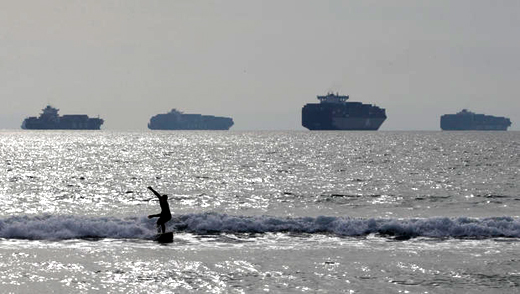
OAKLAND, Calif. — Loading and unloading of cargo ships resumed at ports up and down the West Coast over the weekend, after the International Longshore and Warehouse Union and the Pacific Maritime Association announced a tentative five-year contract Feb. 20.
“After more than nine months of negotiations, we are pleased to have reached an agreement that is good for workers and for the industry,” ILWU President Bob McEllrath and PMA President James McKenna said in a joint press release. “We are also pleased that our ports can now resume full operations.”
The new five-year contract covers workers at all 29 West Coast ports. It was reached with help from U.S. Secretary of Labor Tom Perez and Federal Mediation and Conciliation Service Deputy Director Scot Beckenbaugh. U.S. Secretary of Commerce Penny Pritzker also participated in talks last week.
The union and the employers said they would not now be releasing details of the agreement, which must be ratified by the full PMA and by the union rank-and-file.
The longshore workers had been working without a contract since the previous agreement expired July 1.
The new pact was reached after Perez had said he would move the negotiations to Washington, D.C. if the parties failed to reach agreement by a Friday deadline.
The endgame in the talks was complicated by the PMA’s decision to suspend loading and unloading of vessels on six days during the preceding two weeks, based on its claim that a slowdown by longshore workers was behind growing congestion at the ports, and the employers’ refusal to pay holiday and weekend premium pay during the alleged slowdown.
The longshore union responded that employer actions were the real cause of the congestion, a contention backed up by reports in several business-oriented publications.
The 29 West Coast ports, which together handle about a quarter of the country’s international trade, or about $1 trillion a year, are crucial to the U.S. economy.
The ILWU represents some 20,000 longshore workers at the ports, and the PMA represents over 70 multinational carriers and maritime companies.
Long before talks began last May, the ports had begun to experience serious congestion, as a number of factors contributed to slower loading and unloading of vessels.
Speaking on public radio station KQED’s Forum program Feb. 20, Eric Kulisch, trade and transportation editor at American Shipper magazine, cited factors including the increasing use of container ships carrying two or three times as much cargo as the previous generation of ships, and the resulting need for better pre-planning by ocean carriers, terminals, trucking companies and railroads.
“The ships are carrying in the same amount of cargo, but now less frequently,” he said, “and the cargo just gets dumped all at once. And sometimes it’s not being loaded or unloaded at the same regular places because there are different terminals. It’s caused a lot of pain and problems in the system, beyond the current dispute.”
Observers note other factors in the congestion, including changes in the ways chassis, or truck beds, are made available to move loads to and from the ports. Once owned by the maritime terminals, chassis are increasingly owned by trucking firms and third-party leasing companies that may store them away from the docks, often making it harder to make sure the right-size chassis are in the right place at the right time.
Also speaking on Forum, University of California, Berkeley professor Harley Shaiken noted that the “very skilled” ILWU longshore workers must often accommodate “a lot of less-than-perfect organization” because of the rapid increase in the size of container ships and other changes in the industry.
While details of the new contract are not yet public, Shaiken likened the gains made by the ILWU to those made by manufacturing unions in the 1950s and 1960s, which he said “spread through the entire economy and created a middle class,” setting a standard for all working Americans.
Photo: Surfer rides a wave, Feb. 20, in Sunset Beach, Calif., as enormous loaded cargo ships are anchored outside the Ports of Long Beach and Los Angeles. AP Photo/Jae C. Hong










